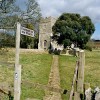“The largest prehistoric monument of its kind in Britain” is how one early antiquarian observer described Maumbury Rings; just ten minutes walk from Dorchester town centre. It is said to have been able to accommodate ten thousand spectators and enclose an area equal to fifty football pitches, although these claims seem a little exaggerated. Certainly the class of monument to which the Rings belong is one found nowhere else in the world outside England, but many other examples of its kind have since been largely ploughed away, including others in Dorset.
Not so Maumbury Rings. This monument is the largest and most important structure of its kind in Britain and has survived intact simply because of its proximity to Durnovaria (Roman Dorchester) and because it has proved so useful for a range of different functions over the centuries. But Maumbury was originally constructed as a henge, one of those still somewhat enigmatic earthworks of England’s Neolithic people, and its origin can be traced back to about 2,500 BC.
It was Sir Christopher Wren who is said to have been responsible for first applying any archaeologically minded scrutiny to Maumbury Rings, though the great eighteenth century antiquarian William Stukeley also wrote about it at some length. Variously described as a “sun temple” or “a Neolithic dewpond,” others fancied the rays of the sun rising in the east passed through the north-east entrance to strike the rising ground at the opposite end, though this has since been shown to be a fallacy.
A large stone is said to have once stood near or across the south-west entrance, and which was long thought to have been the sighting-stone for solar and lunar observations. It is noted that in 1879 a minor excavation was made in the hope of locating this stone, but none was ever found.
Whatever Maumbury’s original purpose as a Neolithic enclosure was, it may well have suffered the same fate as other henges in the area had not the emperor Claudius resolved to bring Britain into the Roman Empire in 43 AD. When the town of Durovaria was founded it was soon appreciated by some engineers or planners that the Maumbury henge conveniently defined in its own outline an earthwork thought to be easily adaptable to serve as a small amphitheatre for gladiatorial or other entertainment without the extra labour and expense of having to start from scratch. Instead of what had probably been existing insubstantial embankments being levelled into oblivion by ploughing, they were re-inforced with rammed chalk and raised to their present day height.
It is believed that by the first millennium BC Maumbury Rings was in use as a Celtic earthwork, possibly some temple on the lines of Stonehenge. Following the departure of the Roman Legions in about 410 AD, the Rings probably continued in use as a meeting place, but no record exists from the Saxon period. During the Middle Ages the arena became the scene of jousts and other revels.
But it is not until the 17th century that we have a clear record of any major event connected with the monument. During the Civil War the Parliamentarians quickly saw the earthwork’s potential as a defensive site, and turned it into a gunnery emplacement to command the then exposed flank of the town from the direction of the Weymouth Road, up which the Roundheads expected the Royalists to advance. After the Civil War, the macabre rise in popularity of public executions by hanging led to the rings being used for this grizzly purpose. However executions at this locality ceased in 1705.
Rather through hearsay, a story has been handed down about the execution, probably in the late 17th century, notable for its particularly tragic circumstances. The details have apparently never been properly recorded, but a young unnamed woman was sentenced to death for some minor crime by hanging at Maumbury. However, at the time she was condemned she was expecting a child. Not wanting to condemn an unborn child to death as well, the magistrates deferred the mother’s execution until the child could be born in prison.
Following the birth the woman was duly hung, but has ever since left behind the unanswered question of who she was, who the child’s father was, and above all what became of the child. Was the child adopted? Did it die in infancy? Did it grow into adulthood and perhaps emigrate? The tragedy of this case is that it occurred a century too soon for the possible commutation of the sentence to transportation to be enacted. But clearly, this is a mystery, which can never be solved without intensive genealogical investigation.
In 1908 the archaeologist George Cary began the first systematic excavation of the earthwork to be conducted in modern times. Probably Cary hoped that the various romantic imaginings and speculations about the henge’s use in pre-Roman times could be laid to rest once the site’s history was set on a firm footing based upon the evidence of the stratigraphy and finds uncovered. Cary’s first excavation revealed that, as might be expected, sherds of recent pottery, ceramics, and other objects were abundant in the first foot or so of soil removed, and included a Victorian half-penny. But these and some older mediaeval pottery underlying them soon ceased.
By the end of the third season in 1910, two Romano-British graves had been discovered and opened, together with seven shafts approximately of the same age as the henge itself re-exposed in the arena floor. These shafts, which may have served a similar function to that of the comparable pits (Aubrey Holes) at Stonehenge, were found to contain a considerable number of tools made from deer antler, together with Neolithic pottery sherds and flint flakes. Interestingly, the existence of these shafts has led to the conclusion that the Romans experienced considerable difficulties in constructing parts of the arena floor and boundary walling of the amphitheatre.
During a much more recent excavation in the early 1970’s a deep cutting made into the chalk walling on the north east side showed that the Romans had to overlay the prehistoric shafts with rammed chalk in the arena’s western curve in order to stabilise the floor surface. It was therefore evident that the Legionary engineers found it harder than expected to adapt the earthwork to their requirements.
During this excavation another four shafts were exposed, bringing the total known to eleven. During an exploration of the outer part of the north entrance a third grave was discovered in the chalk, this time containing a skeleton of a well-built Romano-British man accompanied by a pottery vessel. But the work of this excavation was mainly concerned with determining the real purpose of the shafts. This was not proved, though it is thought likely that they were flint mines.
Today Maumbury is a tourist landmark and attraction, equally attractive to children and picnickers alike, with its own information board at the northern entrance.



